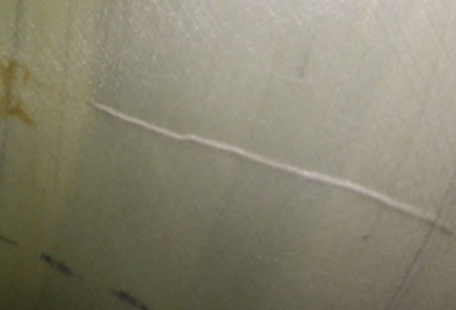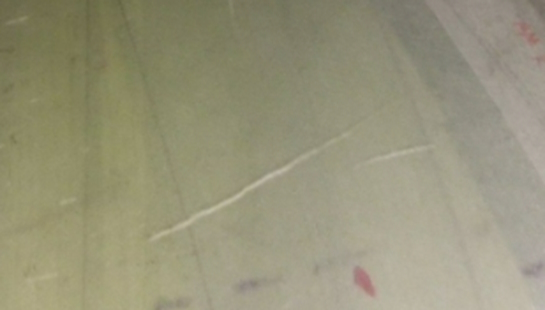Wrinkle Formation and Risks in Composite Materials – Wrinkles refer to undulations or surface irregularities that manifest as visible folds or creases on the outer layer of a composite structure. These imperfections are typically the result of non-uniform deformation, or stresses during the manufacturing process or service life of the composite material.
Wrinkles can occur in various forms, such as small ripples, waves, or more pronounced folds, depending on the specific conditions and factors influencing their formation. The presence of wrinkles in the lay-up of composite materials is undesirable as they can compromise the structural integrity of the final product.
Wrinkle Formation and Risks in Composite Materials
Wrinkles are described as wave-formed plies and/or fiber deviations from straight alignment in UD laminate. Fiber misalignment can occur on UD plies especially at the transition area which can cause wrinkling. UD plies must be placed 0° from blade length axis. Wrinkles can manifest during the layup, resin infusion and curing phases, posing risks to the structural integrity of composite materials. A wrinkle may also occur in butt joints in between core materials, also known as core gaps.
Wrinkles can form both transversely on the UD fibers and longitudinally. Transverse wrinkles pose a higher risk of damage to the blades as they tend to introduce weakness in the laminate, by reducing its tensile performance. As they can disrupt the fiber alignment, the stiffness of the material is compromised, hence negatively influencing the load carrying capabilities of the structure. Transverse wrinkles can contribute to interlaminar shear failures, compromising the bond between adjacent layers in the laminate. This reduction in interlaminar shear strength can lead to delamination, further weakening the structure. The last stage of the transverse wrinkle propagation is the formation of transverse cracks along the defected surface, which can lead to critical damage on the blade.
While longitudinal wrinkles can also impact the performance of unidirectional fiber laminates, they are often considered less critical because they align with the primary load-carrying direction of the fibers. The structural consequences of transverse wrinkles are more pronounced, making them a greater concern in terms of potential mechanical failure and compromised performance in unidirectional fiber-reinforced composites.
Wrinkle development along a blade
Defects that are introduced as outcomes of wrinkle existence can be linked to the load magnitude that is experienced on a localized level. In other words, as the load magnitude is much higher towards the root of the blade compared to further towards the tip, it is more likely for a defect to propagate at the root and hence appear earlier in the lifetime of the blade. It is therefore common for a wrinkle to develop to a delamination or a crack during the first few years of operation if it is located towards the root.


For wrinkles that are located further out towards the tip which are exposed to lower fatigue loads, the defect propagation is expected to progress at a slower pace and the damage is likely to initiate or develop at a later stage of the blade lifetime. Despite the risk of introducing blade damage, wrinkle–related defects can be mitigated proactively if an internal inspection regime is in place. Regular internal inspections can help keeping track of the defect development and/or propagation and assist as a decision-making tool on their criticality and evaluating if they require repairing.
Wrinkle detection
Fortunately, as with other blade defects, wrinkles can be detected in different stages of the blade’s lifetime. Different methods can be used to detect wrinkles in blades after manufacturing and during operation.
Factory QC: After the manufacturing process, load carrying components of thick laminate (e.g., spar caps) are inspected with UT scanning to detect for laminate anomalies such as air voids, inclusions, and air pockets, but also more structurally risky defects like wrinkles. Laminate shell structures are inspected visually for wrinkles post-manufacturing.
Operation: During operation, regular internal inspection campaigns can be very important in assisting with wrinkle detection and propagation monitoring. Wrinkles that are located on laminate shell structures and at the edges of the spar caps transversely can be captured during internal inspections.
Conclusion
Wrinkle formation is a critical issue that threatens the longevity of wind turbine blades. Without proper QC procedures on a factory level that can identify wrinkles in an early stage, prior to operation, these defects can propagate to forming cracks that based on their location can result in catastrophic blade failure. It is important that the owner actively participates in the factory QC process through reviewing the inspection method and results to ensure that no sub-surface wrinkles are present in the spar caps. The next important step regarding wrinkles and limiting their risk for the structural integrity of the blade is during the EoW inspections. During the inspections, any overlooked wrinkles on the shells and webs from the factory QC or any wrinkles that were considered within tolerances and started developing shall be observed. Wind Power LAB can assist turbine operators in both abovementioned important stages of a turbine blade cycle.
Feel free to contact us by clicking here



